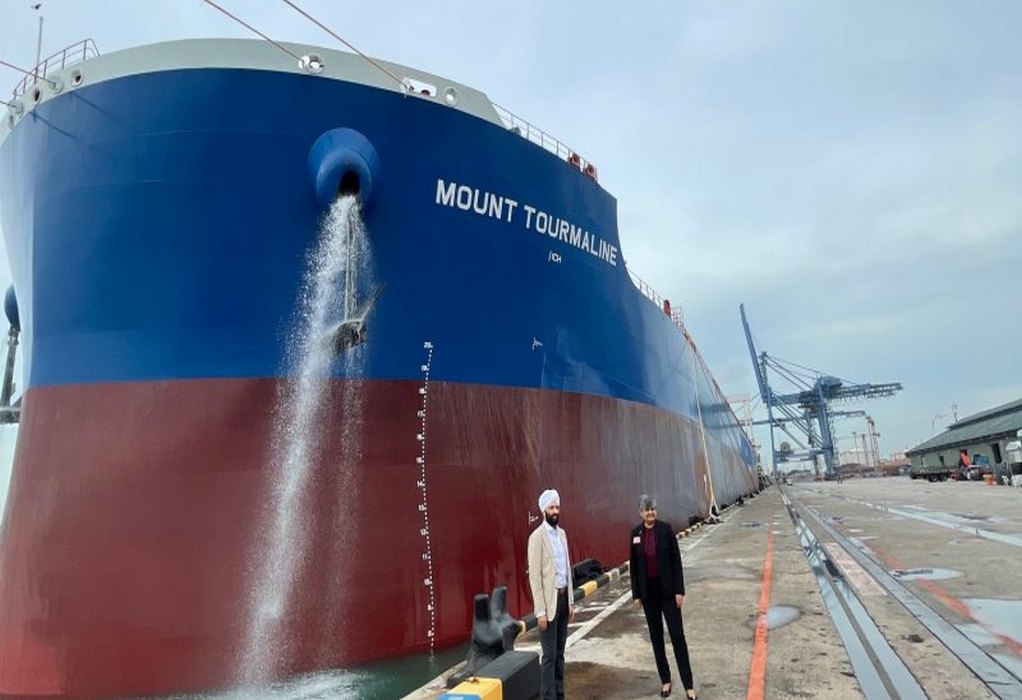BHP, the largest Australian mining company, has marked the delivery of the first of five bulk carriers that will be powered by liquefied gas instead of highly polluting bunker fuel to transport shipments of iron ore from the Pilbara to Asia.
As part of the mining giant’s efforts to slash emissions across its supply chain, BHP has chartered the world’s first fleet of Newcastlemax bulk carriers from Eastern Pacific Shipping, which will run on liquefied natural gas (LNG) supplied by Shell.
Introducing LNG-powered ships would eliminate NOx (nitrogen oxide) and SOx (sulphur oxide) emissions, and sharply reduce carbon dioxide emissions, according to BHP.
The first of the new ships, the MV Mt Tourmaline, arrived in Singapore on Monday to be filled with LNG. The 209,000-deadweight tonne vessel will then leave for Port Hedland in Western Australia to be loaded with iron ore.
BHP chief commercial officer Vandita Pant said the vessel would deliver significant improvements to energy efficiency and emissions intensity, and would reduce overall greenhouse gas emissions across the company’s value chain.
“These LNG-fuelled vessels are expected to reduce greenhouse gas emissions intensity by more than 30 per cent on a per-voyage basis compared to a conventional fuelled voyage and will contribute towards our 2030 goal to support 40 per cent emissions intensity reduction of BHP-chartered shipping of our products,” Ms Pant said.
It comes as BHP and other global resources companies are increasingly targeting new ways to reform their businesses to reduce the vast carbon footprint caused by the mining, shipping and end-use of their products.
BHP has adopted some of the industry’s most stringent climate targets to date, vowing to cut its direct emissions by 30 per cent by the end of the decade and hit “net-zero” emissions by 2050. Last year it announced expanded targets requiring the shippers of its products and suppliers of goods and services to reach net-zero by 2050, as well as a “goal” for net-zero Scope 3 emissions” – the greenhouse gases released when customers burn or process the raw materials BHP sells.
Pressure for miners to sign up to bolder decarbonisation targets and reduce their usage and output of planet-heating greenhouse gas emissions has been building from climate activists and powerful shareholders alike, as investors seek to reduce their exposure to fossil fuels on ethical and financial grounds.
Cyril Ducau, chief executive of Eastern Pacific Shipping, said Monday’s historic LNG bunkering was a sign that the industry’s “energy transition is in full swing”.
“They represent a culture shift in shipping and mining,” he said. “These ships tell both industries that significant carbon emission reduction is available today and necessary to implement, as we work towards net-zero solutions.”
Source: https://www.brisbanetimes.com.au/
Tags: BHP, LNG, Shell, Singapore



Recent Posts
Himachal Pradesh Plans Major Boost to Public Transport with E-Buses and Digital Upgrades
Ammonia-Fueled Container Feeder Design Marks Progress in Maritime Decarbonisation
ABS Develops Industry-Leading EV Battery Fire Simulation Modeling
Wilhelmsen Ships Service Joins the Maritime Battery Forum to Accelerate Maritime Electrification
Indian Student Team Wins Communication Prize at Monaco Energy Boat Challenge 2025
Babcock’s LGE Business Secures Contract for Marine Ammonia Fuel System to Advance Shipping Decarbonisation
Associated Terminals Deploys Liebherr’s All-Electric Cranes in Landmark Move Toward Cleaner Cargo Handling
Sanmar delivers fully electric emissions-free tug to major global operator Svitzer